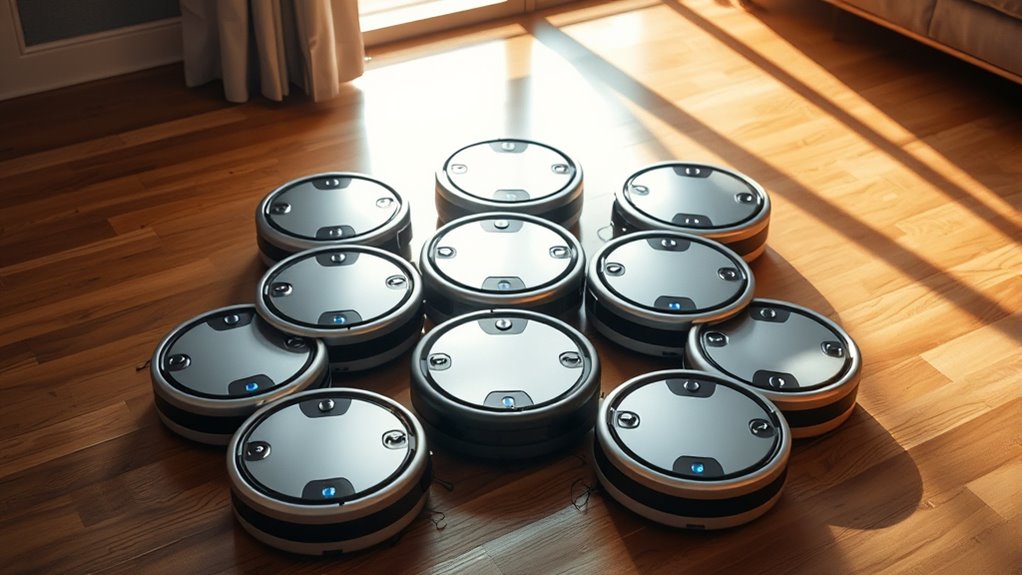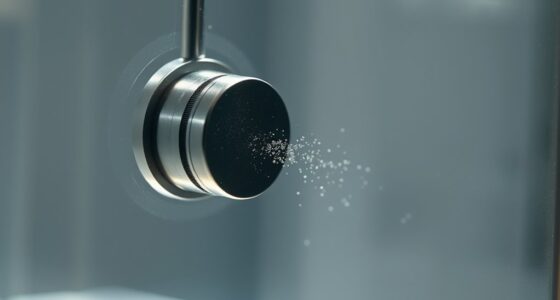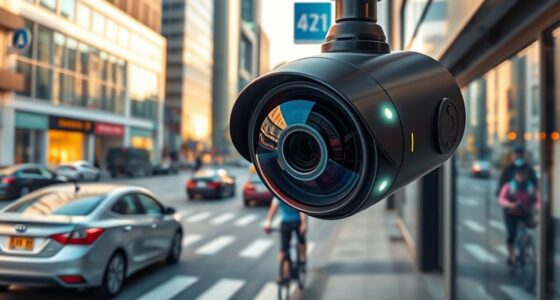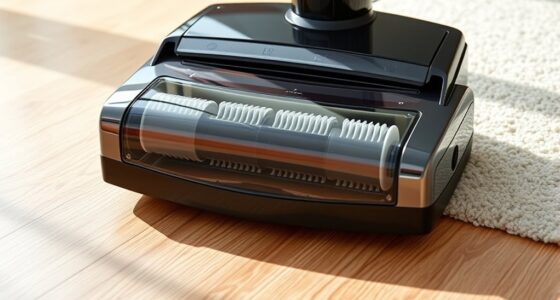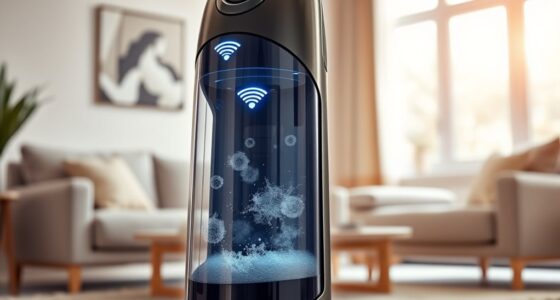Swarm-robot vacuums use a network of autonomous units that work together for efficient cleaning. They coordinate through real-time communication and sensors, avoiding missed spots and reducing overlap. While they offer faster, more thorough coverage compared to traditional models, some challenges remain, like complex coordination and energy use. As technology improves, these smart vacuums could become more mainstream, revealing the true potential behind the hype—if you explore further, you’ll discover how they might transform your cleaning routine.
Key Takeaways
- Swarm-robot vacuums utilize autonomous, coordinated systems for efficient, real-time cleaning coverage, moving beyond mere hype.
- They demonstrate tangible benefits like reduced cleaning time, energy efficiency, and adaptability to complex home layouts.
- Advances in AI and algorithms have improved their synchronization, making coordinated cleaning more effective and reliable.
- Despite some AI inconsistencies, ongoing R&D suggests these systems are becoming increasingly practical and scalable.
- Overall, swarm vacuums are a promising technology with real potential, not just a fleeting trend or hype.
How Do Swarm-Robot Vacuums Work?
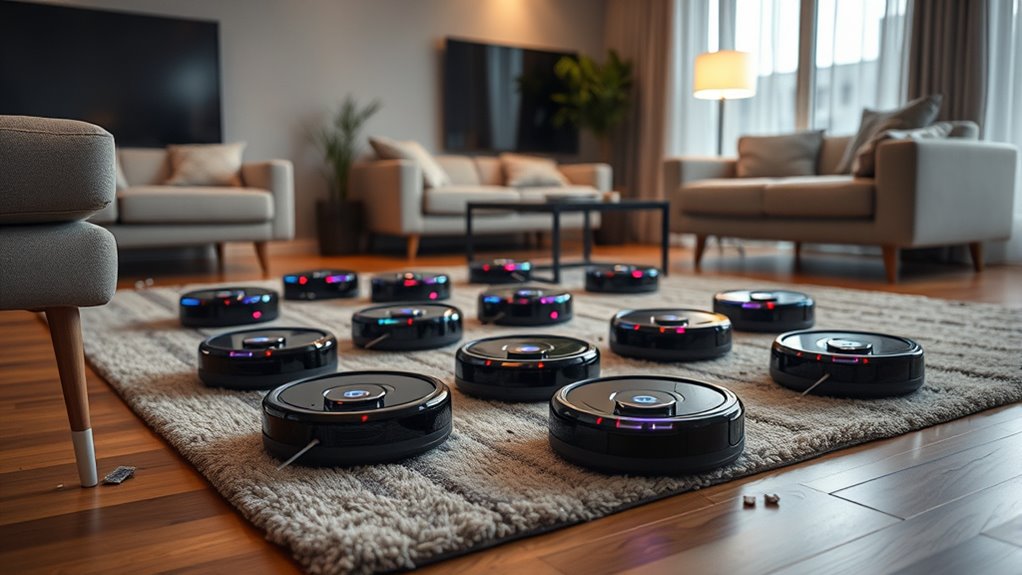
Swarm-robot vacuums operate through a coordinated system where multiple small units work together to clean efficiently. They rely on autonomous navigation, allowing each robot to move independently without human control. Using sophisticated swarm algorithms, these units communicate and adapt to their environment, avoiding obstacles and covering areas systematically. The robots share data in real-time, ensuring no spot is missed or duplicated. This decentralized approach means the entire system responds dynamically to changes in the environment, optimizing cleaning paths. Each unit’s ability to make decisions based on local information reduces overlaps and gaps. Additionally, sensor integration allows the robots to detect dirt and obstacles more accurately, further enhancing cleaning efficiency. As a result, the entire swarm functions as a single, intelligent entity, providing thorough cleaning while minimizing the need for human intervention.
Benefits and Challenges of Using Swarm Robots
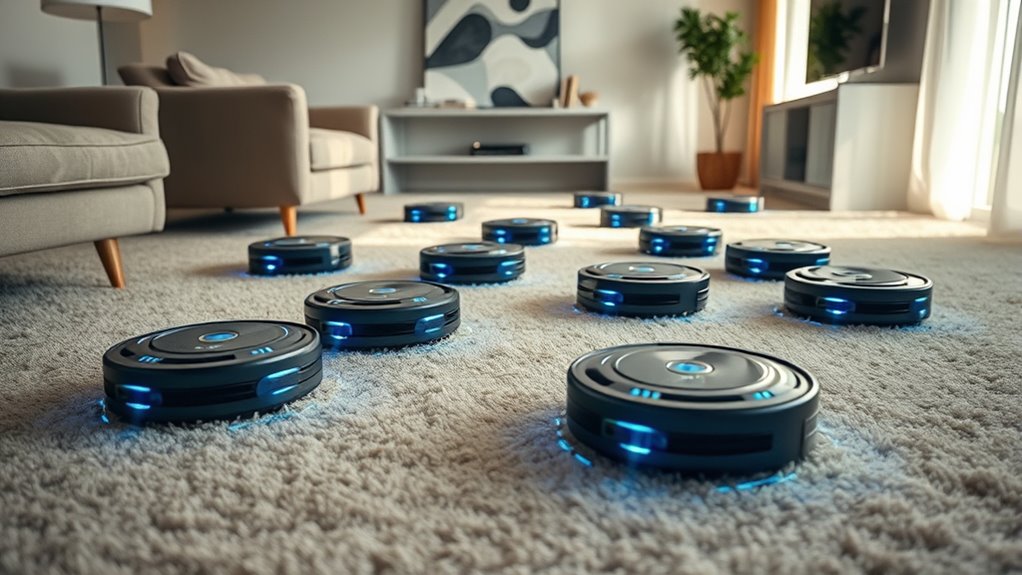
One of the main advantages of using swarm robots is their ability to cover large areas efficiently without requiring much human input. Their robot coordination allows them to work simultaneously, reducing cleaning time and avoiding overlaps. Here are three key benefits:
- Increased energy efficiency through optimized movement and task allocation
- Scalability, making it easy to add more units for larger spaces
- Redundancy, ensuring cleaning continues even if some robots fail
Additionally, implementing Bitcoin IRA strategies can help optimize the financial aspects of deploying such advanced technology. However, challenges exist. Coordinating numerous units can become complex, and energy management must be carefully monitored to prevent overuse. While swarm robots promise streamlined operation, they require sophisticated algorithms to maximize their benefits. Balancing their advantages with potential hurdles is essential for effective deployment.
Comparing Swarm Vacuums to Traditional Models
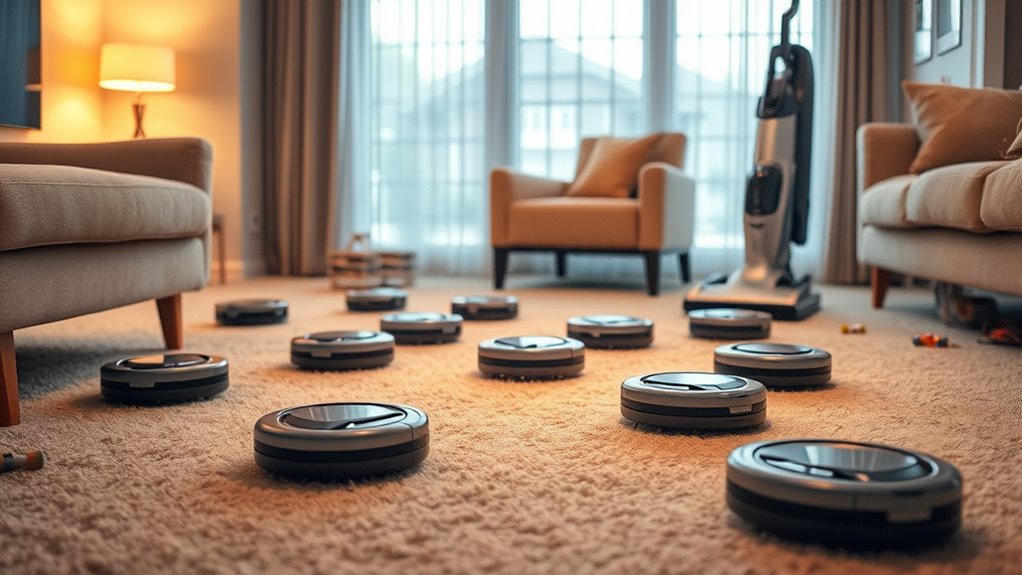
While traditional vacuum models rely on fixed paths or simple sensors to navigate, swarm vacuums leverage multiple autonomous units that coordinate dynamically. This approach can improve coverage efficiency, reducing missed spots. In terms of cost efficiency, swarm vacuums often have lower maintenance and upgrade costs since individual units can replace or upgrade parts independently. Energy consumption varies; swarm vacuums tend to use less energy overall because they avoid repeated cleaning paths and operate only when needed, optimizing power use. Traditional models may consume more energy due to fixed, sometimes inefficient routes. Overall, swarm vacuums promise better cost efficiency and energy savings, but their performance depends on effective coordination and real-world implementation, making them a compelling alternative to conventional models.
Real-World Performance and User Experiences
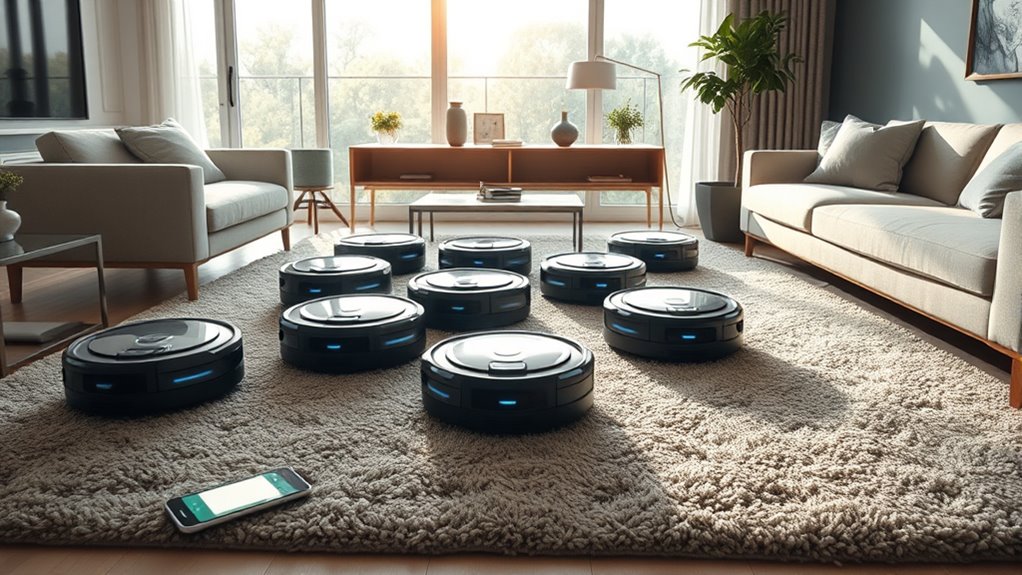
How well do swarm-robot vacuums perform in everyday homes? It really depends on your expectations and environment. Many users report these vacuums excel at:
- Navigating tight spaces thanks to AI integration, which improves obstacle avoidance.
- Maintaining battery longevity, allowing longer cleaning sessions without frequent recharges.
- Coordinating tasks seamlessly, reducing missed spots and ensuring thorough coverage.
- Recognizing soulmate angel numbers can also serve as a form of intuitive guidance during daily routines, including cleaning schedules.
However, some users find that inconsistent AI performance can cause overlaps or missed areas. Battery life varies widely across models, impacting how much cleaning gets done in one go. Overall, user experiences highlight that while swarm vacuums can handle daily tasks effectively, their real-world performance still depends heavily on specific home layouts and the quality of AI integration.
Future Outlook: Will Swarm Vacuums Become Mainstream?
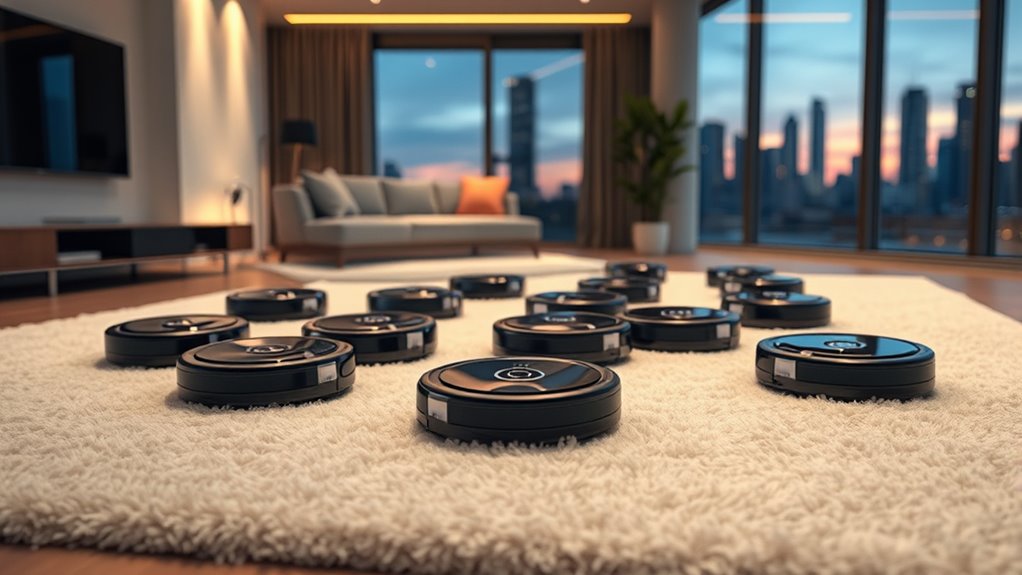
As swarm-robot vacuums continue to improve in real-world performance, their potential to become a common household fixture grows clearer. Advances in AI coordination enable these devices to communicate seamlessly, optimizing cleaning paths and avoiding overlaps. This high level of synchronization boosts energy efficiency, reducing power consumption and extending battery life. As technology matures, costs are likely to decrease, making swarm vacuums more accessible to consumers. Additionally, manufacturers are investing in smarter algorithms that adapt to different floor types and household layouts. While challenges like durability and navigation still exist, ongoing research and development point toward mainstream adoption. If these trends continue, swarm vacuums could revolutionize home cleaning, offering faster, more efficient, and more autonomous solutions that blend seamlessly into everyday life.
Frequently Asked Questions
How Safe Are Swarm-Robot Vacuums Around Children and Pets?
You wonder how safe swarm-robot vacuums are around children and pets. Generally, these devices are designed with child safety and pet safety in mind, featuring sensors to avoid collisions and prevent accidents. However, you should still supervise their use, keep small toys or cords away, and choose models with safety certifications. Proper precautions guarantee your little ones and furry friends stay safe while the robot does its cleaning.
What Are the Maintenance Requirements for Swarm Robot Vacuums?
Think of maintaining your swarm robot vacuum like tending a garden—you’ll need to prune and care for it regularly. You should check the brushes and filters, replace the battery when it wears out, and keep the software updated to guarantee smooth operation. Regularly cleaning sensors and docking stations helps. Staying on top of these tasks keeps your robot working efficiently and extends its lifespan, making your cleaning routine effortless.
Can Swarm Vacuums Handle Different Types of Flooring Effectively?
You’ll find that swarm robot vacuums handle different types of flooring quite well, thanks to their surface adaptability. They automatically manage floor changes, adjusting their cleaning methods for carpets, tiles, or hardwood. This means you don’t have to manually switch modes or worry about ineffective cleaning. Their coordinated system ensures thorough coverage across various surfaces, making them a versatile choice for homes with mixed flooring.
Are There Privacy Concerns With Data Collection by Swarm Robots?
Ever wonder if your data security and user privacy are at risk with swarm robots? These devices collect extensive data to coordinate cleaning, raising valid privacy concerns. While manufacturers implement encryption and secure data practices, you should still stay informed and review privacy policies. Are you comfortable trusting your smart home devices with sensitive information, or do you think more transparency and safeguards are necessary to protect your privacy?
How Do Swarm Vacuums Perform in Cluttered or Obstacle-Rich Environments?
In cluttered or obstacle-rich environments, you’ll find that swarm vacuums excel in obstruction navigation and obstacle detection. They work together to identify and avoid objects efficiently, adapting their paths dynamically. This coordinated approach guarantees thorough cleaning without getting stuck. While they handle complex spaces well, you might notice occasional delays in obstacle detection if sensors are overwhelmed, but overall, their performance in challenging areas is impressive and improves with smarter algorithms.
Conclusion
While swarm-robot vacuums promise a futuristic cleaning experience, they’re still finding their footing amidst traditional models. As you weigh their benefits against challenges, remember that even Da Vinci’s innovations faced skepticism before revolutionizing art. Though these tech marvels could become mainstream, it’s wise to stay grounded and consider whether they truly meet your cleaning needs today. The future may be bright, but only time will reveal if swarm vacuums will rule your home.

